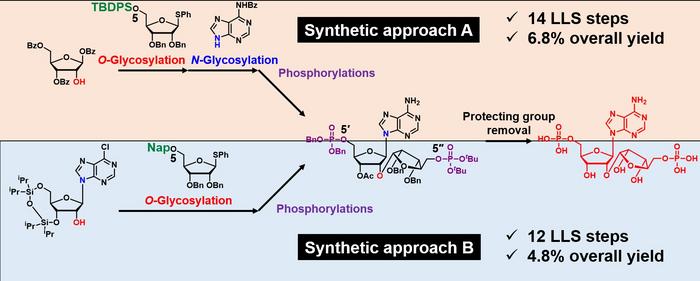The Molecular Maestro: Synthetic Poly(ADP-Ribose) and Its Promises
Gifu University researchers develop synthetic versions of poly(ADP-ribose), a molecule key to cell growth and genetic protection, opening doors to new medical treatments
Nov 30, 2023
[Credit: Hiromune Ando and Hide-Nori Tanaka]
Picture a cellular maestro orchestrating life's symphony at the molecular level, a sugar-based molecule with a repertoire that includes guiding cell growth, safeguarding our genetic blueprint, and even dictating when a cell should take its final bow. This is poly(adenosine diphosphate ribose), or poly(ADP-ribose) for short, an unsung hero in our biological narrative. Nestled within the bustling world of our cells, it holds secrets that could revolutionize disease prevention and treatments—a puzzle that scientists are eagerly striving to solve.
At the forefront of this scientific endeavor, researchers at Gifu University’s Institute for Glyco-core Research (iGCORE) in Japan have stepped into the limelight. They have crafted two synthetic variants of an ADP-ribose fragment, an achievement proudly unveiled recently in the European Journal of Organic Chemistry.

As cells choreograph the complex ballet of protein synthesis, translating genetic directives into tangible substances, they employ a host of molecules in a process known as post-translational modification. One such participant is the poly(ADP-ribose) fragment, ribosyl adenosine 5′,5′′-diphosphate. However, its natural variability has long clouded its specific cellular roles in a shroud of mystery.
"The problem is lack of the availability of homogeneous oligo- and poly(ADP-ribose) samples, which are necessary for molecular-level studies to elucidate their detailed functions,” explained co-corresponding author Hide-Nori Tanaka, an assistant professor at iGCORE. He illuminated the issue with clarity, highlighting the challenge of studying these molecular enigmas. “To address this bottleneck and accelerate ADP-ribose biology, we developed two practical synthetic approaches to ribosyl adenosine 5',5"-diphosphate, a fragment of poly(ADP-ribose), for providing structurally well-defined ADP-ribose oligomer and polymer.”

Their scientific odyssey employed two ingenious methods. The first, a stepwise assembly using a commercially available solution, laid down a foundational framework, to which carbohydrates were meticulously added. The second method streamlined the process into a single, elegant step, transforming a known molecule into a versatile building block primed for ADP-ribose synthesis.
Tanaka, with the vision of a pioneer, shared, “The next step is ADP-ribose oligomer synthesis using the building block we prepared in this paper. Our ultimate goal is to elucidate the detailed functions of oligo- and poly(ADP-ribose) by chemical biology approach using synthetic molecules.”
In this quest, the fusion of chemistry and biology promises to reveal the hidden roles of this enigmatic molecule, potentially unlocking new avenues in disease prevention and treatment. It's a journey not just of scientific discovery but of understanding the very language of life itself.


















